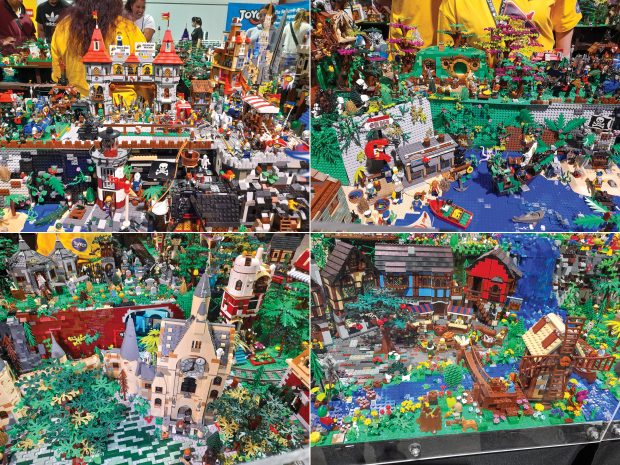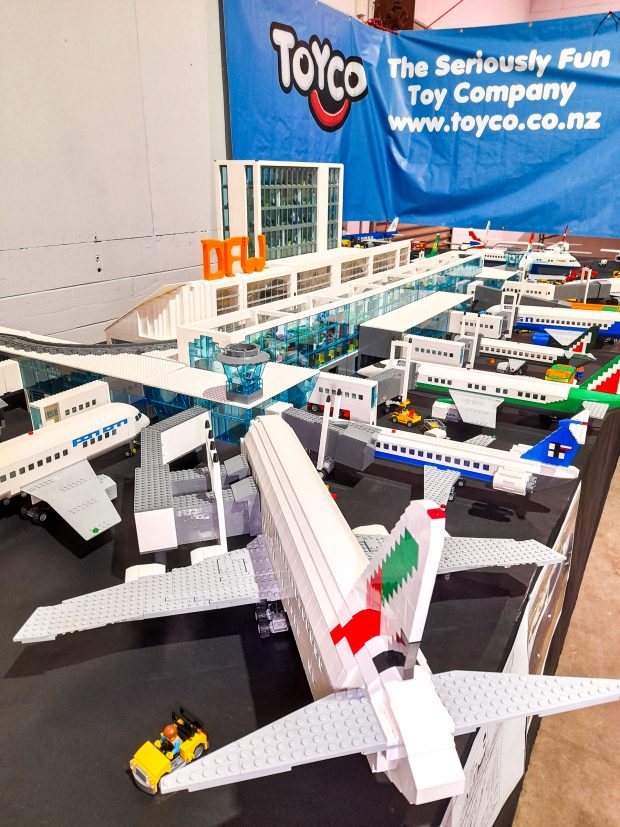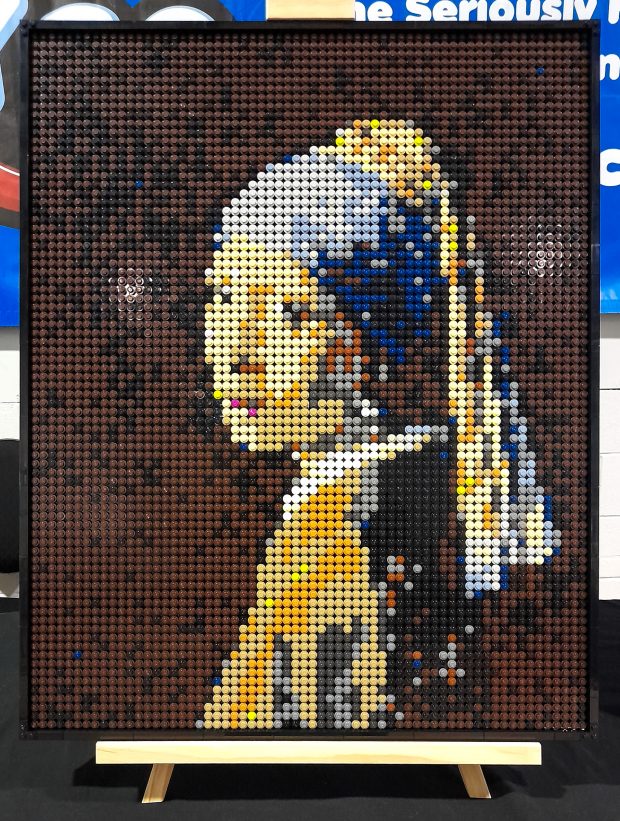Event: Auckland Brick Show
Let’s see how a LEGO User Group (LUG) in New Zealand collaborated with a larger pop culture event to put on a uniquely 2020 brick show in Auckland!
The 2020 Auckland Brick Show took place October 24th through 26th under the umbrella of Armageddon, a large pop culture convention. Because New Zealand does not have active community transmission of COVID-19, it is possible to have large-scale public events like this with 50,000 people in attendance.
Armageddon takes place in a large showground and occupied the larger exhibition building complex. The Brick Show was in a second building of approximately 12,000 feet of exhibition space. Between the two buildings were many outdoor activities and food stands as part of the event and kept the crowds moving between the two buildings. Auckland Brick Show featured about 50 exhibitors from both the organizing LEGO User Group AUCKLUG and guest exhibitors from all over New Zealand.
Let’s take a look at some of the best models on display and see if there were any emerging trends in the LEGO community. We’ll also explore what it was like to participate in a LEGO event hosted in combination with a large pop culture event during these strange times.
Highlights from Auckland Brick Show
The show featured the broad range of models that most brick shows are known for, with exhibitors all showcasing their unique interests. We will look first at some of the models which were awarded prizes and then will explore some emerging themes or novel models.
The Auckland Brick Show is one of New Zealand’s largest brick shows, so it also attracts a good contingent of exhibitors from other LUG’s around New Zealand. The committee therefore awards a Best in Show and a Best in AUCKLUG prize, along with several committee choice commendations.
Best in show
The Auckland Brick Show is one of New Zealand’s largest brick shows, so it also attracts a good contingent of exhibitors from other LUG’s around New Zealand. The committee therefore awards a Best in Show and a Best in AUCKLUG prize, along with several committee choice commendations.
The winner of the Best in Show award was Melissa and Andrew Peterson’s model. This display featured a wonderful mash up of so many popular LEGO themes, licensed themes and MOCs. It included Harry Potter, Star Wars, Disney Princess, Minecraft and so much more. The display is set out in a square and it was quite easy to do several laps around it spotting all the detail contained in the model.
Colin Doyle, AUCKLUG president and one of the judging committee, explained that the judging committee considered how the display embodied LEGO’s sense of humor and rewarded the audience with lots of little stories within the model. The display also featured several trains with timed stops, which had been carefully designed to avoid collisions. All the more impressive, since it was the Petersons’ first public exhibit!
Best in AUCKLUG – ‘Summer and Winter Resort’ by Susan Day
Susan Day was awarded Best in AUCKLUG for her model featuring a winter resort combined with a summer canal-side chalet resort. This model was also packed full of mini-figure story telling.
The chalets are based on a real resort in Rotorua which is a popular holiday spot in New Zealand featuring several lakes along with geothermal areas. After the first COVID lockdown, Susan spent some time in one of these chalets. The model really captures that holiday experience of escape which takes on a new importance in 2020.
The row of canal-side chalets was really effective in a black and white color scheme, which was simpler than the real-life chalets. This contrasting color scheme was a smart design decision as it really helped visually balance the two sides of the model, since the mountain in the winter resort was so much larger in scale.
‘Great Map of Westeros’ by Anthony Ducre
One of the models awarded a commendation was Well-LUG (Wellington LUG) member Anthony Ducre’s great map of Westeros from the Game of Thrones series. This epic map is 1.2m by 3.6m (3’9’’ x 11’8’’) and set on an ornately decorated brick-built base (pictured).
The model is based on the map of Westeros which appears in the opening credits of the TV show, featuring animated versions of the main settlements across the fictional continent. Anthony created a short video showing his model interspersed with the show’s opening credits – it’s a great way to experience how amazing this model is! (For a detailed look at the moving settlements in action during the Auckland Brick Show check out this video from locally-based Youtube channel Brickscene.)
Anthony’s model features microbuilds of the settlements on the map which are mechanized using LEGO Mindstorms. The model contains 125,000 pieces and took five months of building time.

Anthony Ducre displays his Great Map of Westeros which also features two of the show’s icons as standalone models.
I was fortunate to have Anthony explain a little about the design process to me which enhanced my appreciation of the build. Whilst all the movement is powered by Mindstorms, the type of movement required for each settlement is different. Each micro-built settlement needed some unique design work to achieve suitable movement. Anthony pointed out that while the Iron Islands have a ‘shaky’ movement it was a conscious design decision to leave this mechanism like it this – the thinking being that the people of the Iron Islands are nautical folk and the movement nicely resembled the pitching motion of a ship. Solving the design challenges to give every other micro-scale settlement its characteristic movement is one thing, but to knowingly accept one of these without the need to “fix” it was a wonderful design decision.
Another challenge was building the settlements in microscale while also ensuring the robustness to withstand the mechanized movement. Normally with mechanized Lego models the build gains structural integrity from the overlapping parts, but this is not as possible with the limited number of pieces at microscale.
Anthony also showed some of the more hidden elements of the models including how the Mindstorms are accessed and the North Wall elevator mechanism (pictured), which uses a sinker as counterweight.

The North Wall (left) featured the moving elevator and Anthony lifted off one side of the wall to reveal the mechanism inside including a sinker.
Displaying the model is poignant for Anthony as he conceived the idea for the model with his father and undertook much of the design while his father was terminally ill. He shared a love for Game of Thrones and this project with his father. He started building it once his father had passed, and has created a dedication to his father within the model. What Anthony has achieved with this model is amazing and I am sure his father would be immensely proud of the finished creation.
‘Eastern Temples’ by Nicolo Parolini
Another commended display was a varied collection from Nicolo Parolini. The central display featured two tall temples and other oriental-inspired buildings. The detailing on his large temple was excellent, complemented by a magnificent tree at the other end of the display, which I heard has been growing larger each year!
Nicolo ran a small robot wars arena during the brick show which is really popular with the crowds. He had programmable Mindstorms sumo robots who battle it out. Overall, the committee recognized the high quality of his display and the interactive nature of the robots which are a crowd pleaser.

Nicolo Parolini received a commendation for his excellent work, including these beautifully detailed temples.
Emerging Themes
Brick shows can sometimes offer insights into new themes or trends within the local LEGO community. When I considered what the emerging themes, if any, of this show may be, I found myself getting a little bit more abstract than normal. The two abstract thoughts on possible trends I kept returning to were:
- Models highlighting what we have lost in 2020 as we have experienced pandemic control measures.
- LEGO as an art medium which aligns to some of the product lines that the LEGO Group has been exploring recently.
There were quite a few exhibitors whose displays followed the first trend. Many chose to represent in their models holiday destinations, airports, places they had personally been or city scenes crowded with mini-figures. Whilst the designers may not have overtly been making a statement about how our lives has change this year, I’m sure I wasn’t the only one in the audience to feel longing for earlier times when viewing some of these models. It really sparked nostalgia for the days when we travelled without restrictions, crowded together and just had more freedom to connect with others in day-to-day interactions.
One of the exhibits which triggered this feeling was AUCKLUG member Cameron Ewen’s model of a representation of Dallas/Fort Worth International airport. Like many other great models this too received a commendation. Cameron spent much of lockdown building dozens of airliners and other planes to populate his model, which seems like a perfect antidote to a lockdown.
Moving towards the second trend, recently the LEGO Group has featured some LEGO products as an art medium. To focus on appealing to a wider range of adults, LEGO has been promoted as an art and / or home decor medium. This includes the new LEGO Art theme which uses 1×1 tiles to allow adults to recreate artworks using LEGO, one pixel at a time. Younger builders can enjoy a similar experience with the LEGO Dots theme, which again uses the 1×1 size elements.
One example of this 2D art format at the Brick Show was Hayden Vink’s LEGO versions of real life art using 1×1 round plates [part 4073]. This included a version of Johannes Vermeer’s Girl with a Pearl Earring (pictured).
Hayden, who exhibited a fantastic MOC based on Michael Jackson’s Thriller video two years ago, found himself looking for a more manageable project for this year’s show given these trying times. He decided to try replicating famous 2D art in the LEGO medium. He credits this website with the heavy lifting of adapting famous art works to life in Lego. This site allows any image to be uploaded and converted into a Lego version of the design, with the ability to adjust and adapt to suit. Hayden’s LEGO portraits were a really eye-catching addition to the show. Many visitors viewed them as you do art; moving their viewing distance back and forth to see the wider impression and then the bricks in detail. There is a magical viewing distance where the eyes no longer see the bricks and it just looks like a painting.
As talked about above, the map of Westeros from Game of Thrones was another highlight. Whilst it is not a model based on a 2D map, as the design is based on the opening credits of Game of Thrones, it does still refer to a 2D map at its core.
Partnering with the ‘Armageddon’ pop culture convention
New Zealand has managed for the most part to keep COVID-19 under control in the island nation. It is currently at its’ lowest alert level with no active community transmission. This means large events are not currently restricted, and face masks and social distancing, whilst always prudent, are not required due to no active cases. However, to get to this point, New Zealand has experienced periods of strict lockdown and other restrictions. The border has been closed to almost all foreigners for more than 6 months and this has led to substantial economic impacts given the country’s reliance on international visitors and tourism.
In such uncertain times, holding the annual brick show seemed untenable. The LUG usually hosts its annual brick show over a long weekend in October and attracts more than 20,000 attendees. With the uncertainty of the pandemic, and the possibility of having to return to a temporary lockdown at short notice to control an outbreak, it did not appear prudent to proceed with the financial commitment to host a show. Thankfully an opportunity arose for it to be hosted by New Zealand’s largest pop culture convention, Armageddon, which celebrates its 25th anniversary this year. Armageddon features gaming exhibitors, film and television panels, cosplay, celebrity guests and the usual pop-culture merchandise stands that form part of these conventions. Since NZ’s borders remain closed, all international celebrity guests had to appear virtually for Armageddon, and local stars were able to participate in person.
The showgrounds where the event took place has a large convention building and a second smaller building with 12,000 feet of exhibition space. The Brick Show was held in this second building. Armageddon also fully utilized all the outdoor space on the grounds with a range of activities and supporting food stands. Directly outside the Brick Show was an area for sword fighting, axe-throwing and archery activities provided by a modern medieval fighting club, Auckland Armored Combat. Convention attendees could participate in these activities and the fighting club members held matches to demonstrate their combat abilities throughout the three-day event. Having the medieval fighting club directly outside the hall also led to some nice interactions between the LEGO fans and exhibitors and the historic combat enthusiasts.

Auckland Armoured Combat fighting club held matches directly outside the Brick Show exhibition hall.
All in all, the combination of Armageddon and the Brick Show was a great success. It exposed the Brick Show to a larger audience that would normally be the case, since Armageddon has about 3 times the number of attendees. Many of the visitors to the brick show hall were clearly at Armageddon to support their particular pop culture fandom, however on seeing the LEGO displayed seemed to rediscover their own love of LEGO. There was a definite sense that some new AFOLs were created over the weekend and a few dark ages came to an end as people’s eyes sparked up while wandering the brick show exhibits.

Cosplayers taking a closer look at Jake Roos’ Maxy Figure (More about his 30× sized Maxy Figure in this article and video).
Another advantage of having the Armageddon crowd in the brick show hall was the cosplay. There was a huge variety of pop culture genres and characters from superheroes to steampunk. It was fun to see cosplay Batman stand with a full-size brick-built Batman (pictured) or cosplay Cinderella spotting herself in minifigure form in the Best of Show exhibit.
AFOL’s often build their favorite pop culture references or historic scenes into their models. In addition, there have been so many partnerships between iconic pop culture brands and LEGO in recent years so it totally makes sense that co-hosting LEGO events and pop culture conventions can lead to more enjoyable events for all involved.
I would say that overall, there was such a feeling of joy and connection for all to be able to mingle and share fandoms. AFOL’s enjoyed getting together and doing a normal, if slightly modified, brick show. Pop culture geeks and cosplayers enjoyed seeing their fandoms in the LEGO medium and all the interactions I saw were kind and sincere. It was just a fabulous event to be involved in. People genuinely enjoyed the ability to interact at a large event and have some normalcy back.
If you are involved in your local LUG, I thoroughly recommend that you consider new forms of collaboration for putting on events once in-person events are back on in your area. Trying circumstances can lead to some new ideas and create some really successful partnerships.
If you are not part of a LUG you can identify if there is one in your area via the tools at LEGO’s LEGO Ambassador Network page. For those in New Zealand you can find out more on NZ LUGs here and on AUCKLUG here.











Great write up Christine, and thanks for the mention! Nice to see you again at the show.